

Other Cities and Towns
Besides major metropolitan cities, a number of important cities and towns dot the map of Pakistan. Some have historic linkages, while others are important because of their location and peculiarities. In fact every place in Pakistan has a its own story to tell and its place in the history dating back thousands of years. Some of the these are listed below.
Tomb Bibi Jawandi - Uch (photo courtesy: Autumn Sun and Autumn Colours )
Uch:
At the confluence of the Sutlej and the Chenab is the historic town of Uch. HOW OLD IS THE UCH? No one knows but traces of Uch are found when Alexander the Great came to Uch after conquering the northern parts of India and spent over a fortnight in the city and renamed it Alexandria. That is why the town is often mentioned as Sikandara or Iskalanda. Uch is famous for shrines ornamented with blue mosaic like the ones in Multan.

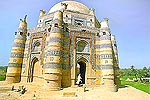
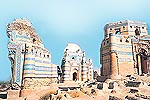
The famous shrines include those of Makhdoom Jahanian Jahangasht, Shaikh Saifuddin Ghazrooni and Bibi Jawandi. The tomb of Bibi Jawandi is the most completing, octagonal in shape, titled in the blue. For the reverence of great saints buried here, the town is respectfully named as Uch Shareef. Bibi Jawandi, the great granddaughter of the saint Jahaniyan Jahangasht, was known for her piety. Her tomb is considered one of the most important, and the most ornate, sites in the town of Uch, which was the centre of Sufism under the Delhi sultanate. In plan it is octagonal on the exterior, with the interior walls angled to form a circle. The thick walls rise to two stories, transforming by way of squinches into a sixteen-sided drum upon which a dome sits, supported by bell-shaped brackets. Both the interior and exterior walls are decorated with a profusion of faience revetment. The tomb is in poor condition. The tomb dates back to 1494 approximately.
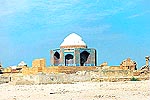
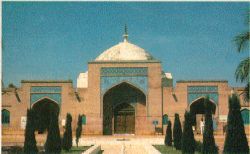
District Office (Left) Railway
Station (Right)
How old is this city anyway?
Since all cities of Punjab have their long histories, so everyone asks about
the same for Gujranwala. Not very old - just some 300-500 years old. The
existence of small villages (now swelled into large size towns) like
Eminabad, Ghakhar and Wazirabad around present day Gujranwala dates
back to 16th century. The area comes to limelight during the Sikh rule of
the Punjab, when the Sikhs established their Empire in the Punjab after the death of the
Mughal Emperor Aurangzeb Alamgir in 1707. One Charat Singh, who
was the head of one of the Sikh Clans, is said to have established his stronghold in
Gujranwala in 1763. Charat Singh died in 1774 and was succeeded by his son,
Mahan Singh, who in turn fathered the most brilliant leader in the history
of the Punjab Maharaja Ranjit Singh. The British annexed the area in 1849. The Deputy Commissioner of that
time Sir Bernardth rebuilt the "Sialkoti Gate" , "Lahore Gate" and "Khiyaaly
Gate" in Gujranwala. A railway line was built along Grand Trunk Road, which interconnected
Gujranwala with other cities of Punjab and made the commercial trade between
cities more convenient. British ruled the city until Pakistan's independence
in 1947.![]()
Gujranwala:
Just an hour's drive from
Lahore, lies the city of Gujranwala on the main Grand Trunk Road. After
Lahore and Faisalabad, Gujranwala is the third largest city of the Punjab
province, famous for grains, melons, sugarcane. The Gujranwala district is
divided between a low alluvial tract along the river Chenab and Degh Nullah
and the upland between these two, which forms the central portion of the
Rechna Doab, intermediate between the fertile submontane plains of Sialkot
and the desert expanses of Jhang. Part of the upland tract has been brought
under cultivation by the Chenab canal. The city is known as the City of
Pehelwaans (wrestlers) since it has produced some of the famous wrestlers of
the subcontinent. People of this city are fond of eating and some of the
best cooked dishes of Punjab like "Tikkas" "Chanps" "Kababs" are the hot
favourites here. However "Chirays" (big sparrows special to Gujranwala) are
a delicacy for which people even from Lahore and Rawalpindi throng
Gujranwala's road side food shops. favourite places of the people.
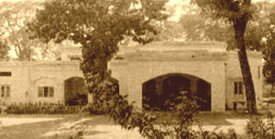
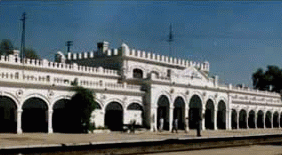
After Independence, most of the Hindu and Sikh residents of Gujranwala, or
in fact from entire Punjab that came into Pakistan, moved migrated to India
and Muslims migratees from India settled down in various areas of Punjab,
including Gujranwala. Gujranwala was given the status of a district in 1951,
which paved way for its progress and prosperity. Today, Gujranwala, besides
its agro-based industry is also famous for manufacturing units / industries
of ceramics, copper, brass, and aluminum utensils and iron safes. Sialkot
and Gujranwala are also famous for producing world 's best quality Basmati
rice. The Gujranwala hydroelectric project provides power from the Chenab
River. Gujranwala is not far behind than Lahore, Faisalabad and Rawalpindi
in holding international level cricket at the Jinnah Stadium, formerly known
as Municipal Stadium.
| HOME PAGE | MORE CITIES |
![]() 29 December 2008
29 December 2008
![]()
Copyright©JalalsPages - 2005 - 2008